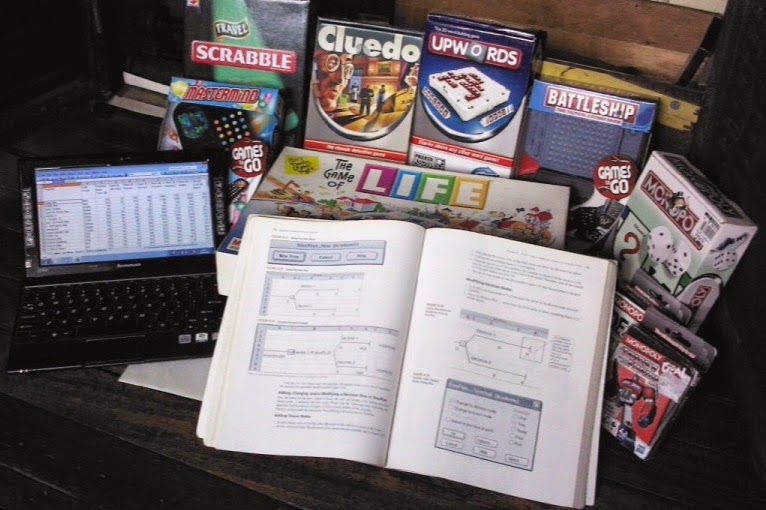Board games in college classrooms and laboratories are nothing new. In a scholarly essay I submitted to the La Consolacion College Manila Research Digest in April 2012 (published October 2012), I spoke about how not-new board and table games are as intellectual pastimes. They were the games of nobles five millennia ago! In spite of being part of the cradle of civilization (the baby teething toy, perhaps), the study and use of tabletop games for scholarly pursuits is relatively still in infancy—and with the study of gamification sharing in the new playpen.
But in this age of quick information exchanges and vast opportunities for creativity, tabletop game use for science and education is growing fast and furious—at least in certain schools of economics and business. I'll confidently say I helped catalyze its growth as a studied science by doing my fair share of trafficking its use in classrooms.
Hasbro has the tools
Across two higher education institutions, two college subjects and three course programs, I used a total of five games, all of them published by the same outfit that brought us the Transformers franchise: Hasbro. Those games and their purposes are:
Risk and Monopoly were used in a [now defunct] subject called Computer Research and Development. Its description as a subject in the IT and Information Systems (IS) programs is not really clear-cut. I then gave it a new description in the direction of gamifying how we make management decisions aided by software applications.
Mastermind, Boggle and Battleship figured in Data Structures and Algorithms. My job was to challenge students to scour the Internet for sample codes and modify them to do code-breaking (or at least code-guessing), word-matching and map-finding.
In the following weeks, I’ll share how I and my classes used the games to satisfy their respective learning objectives.
Risk®
Do you attack East, West, or North? Do you press on or halt the attack? These were just some of the critical questions that consume the time of generals and their staffs.
Sun Tzu’s The Art Of War formulates the military leadership organization as being composed of a supreme general and his staff of military advisers that do the dirty work of calculating the math of war. That was more than 2,000 years ago in a land of warring states (which would be known as China). Fast-forward to World War II, the very nature of war became like performance-enhancing drugs to a toddler—the electronic computer being the toddler.
I first got my class to unthink contemporary gaming for the times being (one hour and 30 minutes each class). No Warcraft DoTA, no fantasy MMORPG (massively-multiplayer online role-playing games). I chose to use Risk®—played in its World Domination mode—for the following reasons:
I assigned the students to act as groups of belligerent nations, three against another three. There are observers and documenters on both sides. Their role is to record casualties territories gained or lost, and even determine the likelihood of retaliations by neighboring enemy units. One student photographs the lay of forces on the map--like History Channel's World War II From Space (in between pathetic programs about storage, swamps, catfish hand-fishers and pawn shops).
World domination in one-and-a-half hours?
No. Unfortunately, that didn’t happen and has no chance of happening. I was already “multi-tasking” by facilitating the other half of the class playing Monopoly (to study economics aided by spreadsheet software). The 18 weeks in a semester just weren’t enough.
What I did was gather records of events (from at most five turns) that have happened and discuss the results for the class to look into. Could there have been patterns in the turns? Does the information somehow help “the general” peer into the next one or two turns and predict the likely outcomes? If one will scale the information to the level of real-life and we just might be able to see outcomes and their effects on geography in timelines of days and weeks.
What we have learned
Aside from being one of the campus building’s top noise generators, the whole process of recording turn information and geographical changes on spreadsheets and detecting patterns saw the beginnings of decision-support system design. Such designs are not normally made available to the general public for a number of reasons. Three such very likely reasons are:
In being a lecturer of those three subjects (excluding History) and their other closely-related disciplines, I found it insufficient to explain theory through "textbook regurgitation" (as many teachers of college MIS do). It is also way too costly--to say the least--to instigate a real war to learn how information system parts come together, or to test if they actually give some competitive edge.
So, my guide for fellow teachers: create an environment that engages students to “make war” and treat it like a living thing with vital signs. Use spreadsheets like Microsoft Excel or Google Sheets to show the mathematical anatomies of winning, losing and the what-ifs. Answers to questions about what could've been is, more often than not, one of the main reasons for studying information systems.
Yup! We will be seeing Mr. Monopoly next week. Until then, read these Risk tips.
But in this age of quick information exchanges and vast opportunities for creativity, tabletop game use for science and education is growing fast and furious—at least in certain schools of economics and business. I'll confidently say I helped catalyze its growth as a studied science by doing my fair share of trafficking its use in classrooms.
 |
| It must be the funny hat, Napoleon. You made many people drunk thanks to a brandy named after you as well figuring as a clumsy out-of-time general in Bill and Ted's Excellent Adventure. |
Hasbro has the tools
Across two higher education institutions, two college subjects and three course programs, I used a total of five games, all of them published by the same outfit that brought us the Transformers franchise: Hasbro. Those games and their purposes are:
- Risk (quantifying decisions in war);
- Monopoly (quantifying decisions in economics);
- Mastermind (analyzing problem-solving efficiency);
- Boggle (analyzing pattern-detection and database-querying efficiency); and
- Battleship (determining likelihood of planar location and orientation)
 |
| Games for computing and business college classes? Spreadsheets are indispensable in the hands of observers and documenters. The book is Spreadsheet Modeling For Business Decisions by John Kros (2008). |
Mastermind, Boggle and Battleship figured in Data Structures and Algorithms. My job was to challenge students to scour the Internet for sample codes and modify them to do code-breaking (or at least code-guessing), word-matching and map-finding.
In the following weeks, I’ll share how I and my classes used the games to satisfy their respective learning objectives.
Risk®
Do you attack East, West, or North? Do you press on or halt the attack? These were just some of the critical questions that consume the time of generals and their staffs.
Sun Tzu’s The Art Of War formulates the military leadership organization as being composed of a supreme general and his staff of military advisers that do the dirty work of calculating the math of war. That was more than 2,000 years ago in a land of warring states (which would be known as China). Fast-forward to World War II, the very nature of war became like performance-enhancing drugs to a toddler—the electronic computer being the toddler.
I first got my class to unthink contemporary gaming for the times being (one hour and 30 minutes each class). No Warcraft DoTA, no fantasy MMORPG (massively-multiplayer online role-playing games). I chose to use Risk®—played in its World Domination mode—for the following reasons:
- To go back during Napoleon Bonaparte’s time when the world map seemed a lot simpler to map, and warfare as a whole was slower and constrained to ground battles;
- The turn-based game-play enables us to record turn figures (units and territories) for later analysis; and
- There aren’t too many complex factors to consider other than the numbers of soldiers, the number of reinforcements as a result of conquests, and chance.
I assigned the students to act as groups of belligerent nations, three against another three. There are observers and documenters on both sides. Their role is to record casualties territories gained or lost, and even determine the likelihood of retaliations by neighboring enemy units. One student photographs the lay of forces on the map--like History Channel's World War II From Space (in between pathetic programs about storage, swamps, catfish hand-fishers and pawn shops).
World domination in one-and-a-half hours?
No. Unfortunately, that didn’t happen and has no chance of happening. I was already “multi-tasking” by facilitating the other half of the class playing Monopoly (to study economics aided by spreadsheet software). The 18 weeks in a semester just weren’t enough.
What I did was gather records of events (from at most five turns) that have happened and discuss the results for the class to look into. Could there have been patterns in the turns? Does the information somehow help “the general” peer into the next one or two turns and predict the likely outcomes? If one will scale the information to the level of real-life and we just might be able to see outcomes and their effects on geography in timelines of days and weeks.
What we have learned
Aside from being one of the campus building’s top noise generators, the whole process of recording turn information and geographical changes on spreadsheets and detecting patterns saw the beginnings of decision-support system design. Such designs are not normally made available to the general public for a number of reasons. Three such very likely reasons are:
- Very few information systems architects for the military;
- War is business and businesses have trade secrets; and
- The military will not allow you to see their systems’ guts anyway (even when the Freedom of Information Bill has been enacted into law).
In being a lecturer of those three subjects (excluding History) and their other closely-related disciplines, I found it insufficient to explain theory through "textbook regurgitation" (as many teachers of college MIS do). It is also way too costly--to say the least--to instigate a real war to learn how information system parts come together, or to test if they actually give some competitive edge.
So, my guide for fellow teachers: create an environment that engages students to “make war” and treat it like a living thing with vital signs. Use spreadsheets like Microsoft Excel or Google Sheets to show the mathematical anatomies of winning, losing and the what-ifs. Answers to questions about what could've been is, more often than not, one of the main reasons for studying information systems.
 |
| He's got a point. He may have Donald Trump as a follower. |



